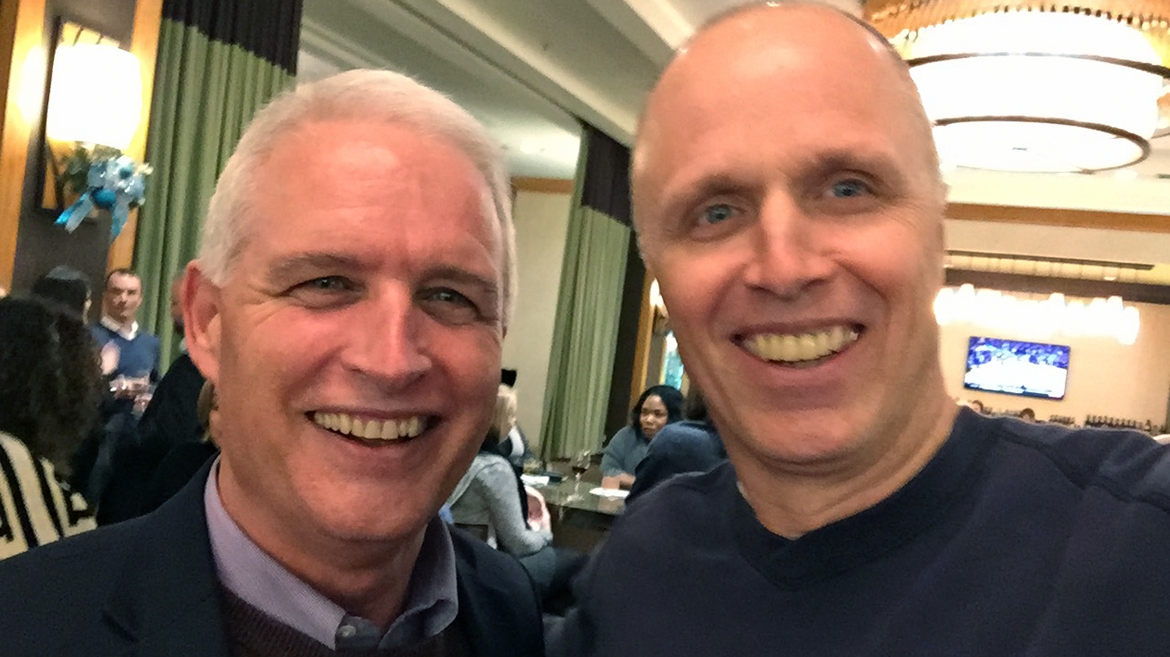
Newsroom

Bill Roske: From ASU to the Alliance Management Institute stage

Bill Roske, right, with ASU Lodestar Center Executive Director Dr. Robert Ashcraft at the 2017 Alliance Management Institute.
Bill Roske graduated from the American Humanics program (now called the Nonprofit Leadership Alliance) at Arizona State University. He worked for several Junior Achievement affiliates after graduation before entering the business world, most recently with SAP, but he maintains many ties to the nonprofit community as a volunteer and board member. Bill presented in 2017 at the Alliance Management Institute, a two-day conference for students from Nonprofit Leadership Alliance affiliates across the country. Here's the story of his journey from student to teacher – and presenting during a Denver snowstorm.
by Shannon Cruz, medium.com/sap-design
Having only been trained once at a 3-day d.camp, Bill Roske didn’t think his first teaching session would involve leading 400 students and faculty members through a 2-day design thinking workshop in Denver, Colorado. Much to his surprise, however, he was put up for the job.
Bill’s design journey began when he was introduced to design thinking as an approach to help his banking customers find the right problems. As a Consulting Manager for SAP, he had limited direct customer interaction, but was searching for ways to add value for his customers. He heard about the design thinking approach while conducting research and decided to enroll in a d.camp to learn the methodology.
Bill attended his first d.camp in 2016 with little knowledge of what design thinking was at the time. For those unfamiliar with what a d.camp is, it is a 3-day hands-on workshop that introduces participants to design thinking basics and methods, and also lends an understanding of how to apply design thinking to real-world scenarios. It is led by Andrea Anderson and her team Design X, an SAP user experience design team located in Palo Alto, California. At the end, participants walk away with a set of techniques that allows them to apply design thinking to their work.
After his first d.camp, Bill’s confidence in helping customers find and solve the right problems at his profession increased. He became more comfortable providing guidance to customers, as he had learned to empathize and to find the best solutions to the most vital problems. He also began applying his newfound skills to other areas of his life, such as at his local YMCA.
Bill even felt confident enough to lead a workshop for the Nonprofit Leadership Alliance at the Alliance Management Institute when he was invited to Denver to lead 2 sessions: “Solving BHAP’s (Big Hairy Audacious Problems) Using Design Thinking,” and a “Case Study” facilitation with students. The two sessions were broken up into students and faculty, each with about 25–100 participants throughout two days.
The student session was fairly easily to facilitate for Bill, as he utilized a pre-designed activity called DP0 Gift Giving Experience. This was created by the Stanford d.school, and it provided him with 80% of the material he needed to expose students to design thinking quickly in a hands-on fashion. The engagement eventually resulted in creative and useful prototypes.
Bill’s second session was to advise undergraduate university-level faculty and nonprofit professionals in a design thinking workshop. Their agenda was focused on how they could implement design thinking in their workplaces. Bill had to pull information from several existing slide presentations, plus add some unique insights to directly apply the concept to this new audience. But, he was proud to see the entire group of 50 university faculty and nonprofit executives fully engaged in the topic, and asking insightful questions.
The Case Study session is when things got tricky, however. Bill initially created an agenda for a group of 10 students to solve real problems for a Denver nonprofit agency. The intent was to visit the nonprofit in person and work directly with their stakeholders to solve their design challenge. Much to everyone’s surprise, however, there was a heavy snow storm.
This changed the agenda tremendously. All 400 students were stuck inside the large ballroom at the Sheraton Hotel. Instead of Bill working with only 10 participants, Bill would be leading all 400 through a design thinking workshop.
With little time to tweak his plan, Bill found himself on the stage presenting his newly devised agenda to all 400 students at once. Each group of 10 students was already assigned to one of the 40 local nonprofit agencies and had a unique problem statement to solve for their agency. Yet, Bill was able to provide a common structure that guided the groups through each design thinking phase.
Over the next six hours, Bill allowed the groups to diverge, then brought them back together in the Grand Ballroom to help them converge. In the end, each group presented their agency with five, ten, or more ideas for a solution. Feedback from students was overwhelmingly positive, and many appreciated the ideation process, while some even said that this remotely-guided approach was better than in previous years at the conference, as it allowed them to spend more time discussing solutions.
From working through a 3-day design thinking camp to teaching 400 students about the topic, Bill’s experience is unlike any other student who has applied his or her learnings in a real-world scenario. Now, Bill is striving to help others who are looking to utilize design thinking.
I thoroughly enjoyed applying my new Design Thinking skills to help people who are attacking some of our world’s biggest problems. Presenting to both college students and university faculty was a challenge but also fulfilling.
Bill Roske
Design thinking is like any other method. It must be learned and practiced so it becomes almost secondhand in nature. Bill is an inspirational example of how taking one d.camp can lead you along a wildly successful journey.
Background on Bill: Bill has been with SAP for over 11 years. Before that, he started his career at Accenture, was part of an early cloud startup, and worked in the nonprofit industry for ten years. His claim-to-fame at SAP is his work in 3 key board areas: Support, Product & Innovation, and Services. But, it always involves helping customers setup and/or use software. He is currently continuing his role managing the NA Financial Services Consulting practice but is looking for more ways to apply his design thinking skills.